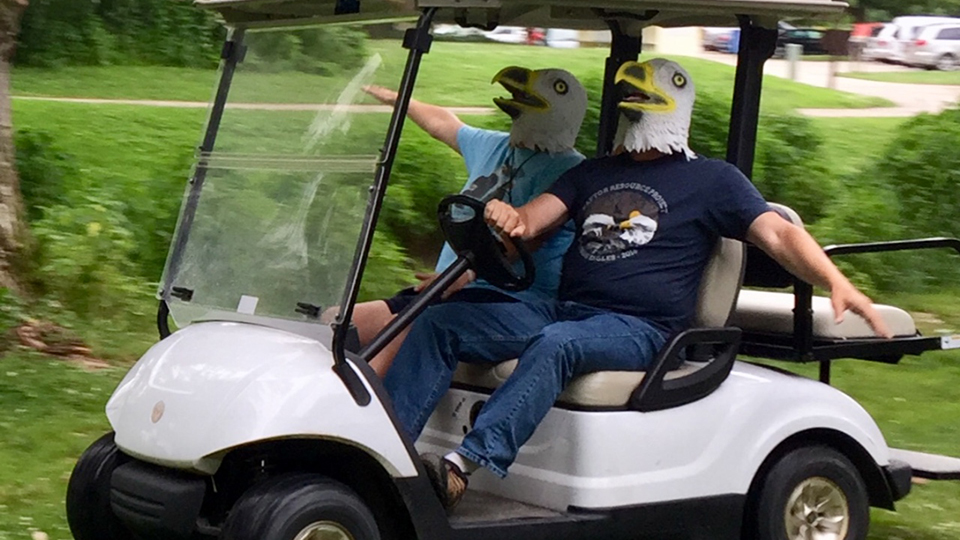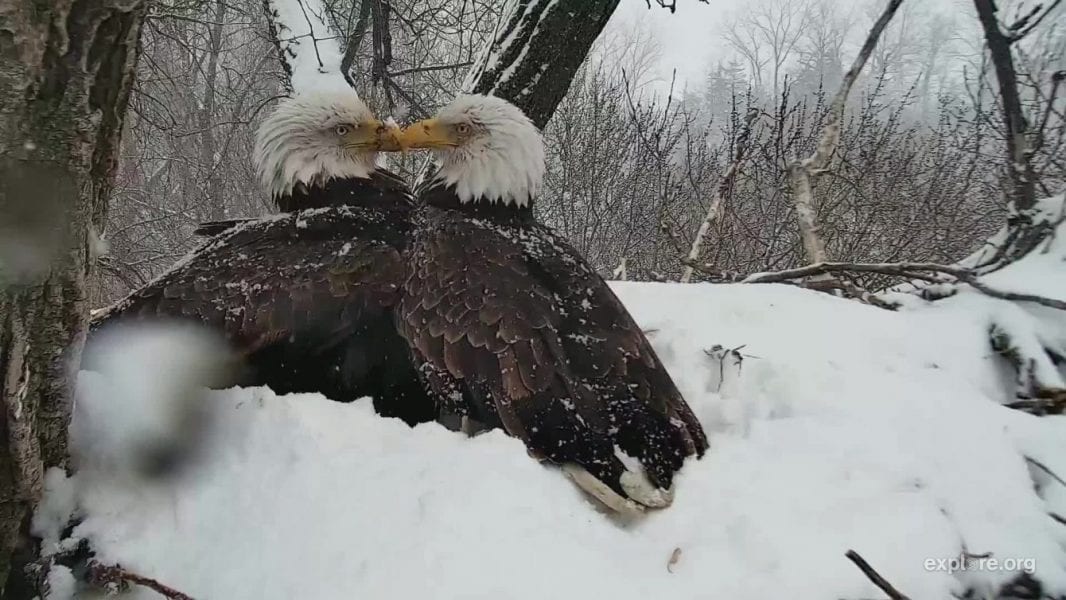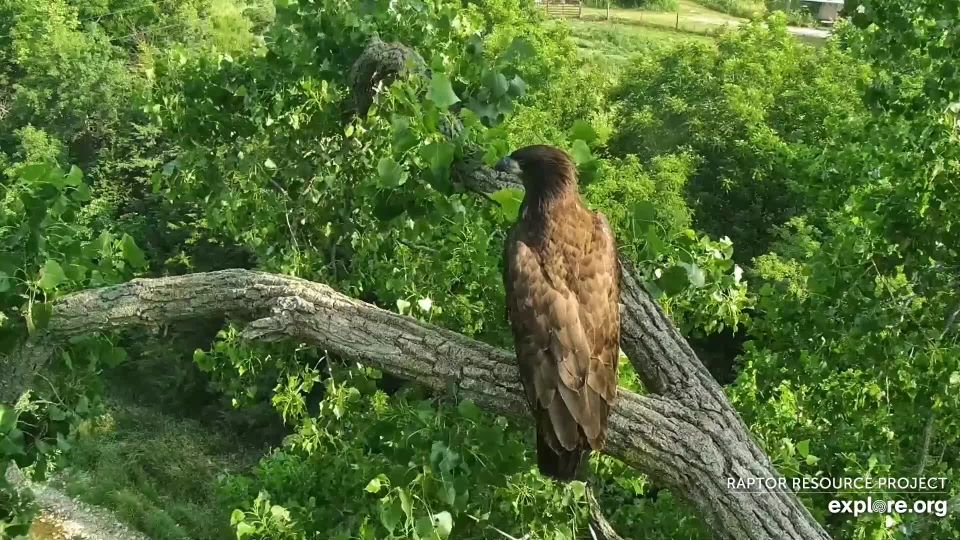We’ve been getting a lot of questions from followers old and new. Who is the Raptor Resource Project, what do we do, where are we located, and what’s with this alphabet soup of eagle names? We are a non-profit 501c3 organization located in Decorah, Iowa. We research birds of prey and operate streaming cams from three bald eagle nests, multiple peregrine falcon nests, a turkey vulture’s nest, and an island in the Mississippi River. We organized to breed and release peregrine falcons in 1989, but we are best known for our work with the Decorah Eagles and streaming in general.
How the Decorah Eagles began…
In 2006, filmmaker Neil Rettig was looking for a bald eagle nest to film for the documentary movie American Bald Eagle. He approached our founder, Bob Anderson, who told him about a nest in Decorah, Iowa – not far from Neil’s place and just ten minutes or so from Bob’s house. The two men set up cameras in the nest and collected footage. Once it was done, Bob decided to put the eagles online, although the feed didn’t blow up until we started streaming to Ustream in October of 2010. The stream was available 24×7 to anyone who wanted to see what life in a Bald Eagle nest looked like.
Won’t this be fun?
“Won’t this be fun?” Bob asked. It was October of 2010, the sun had set and we’d just watched a mouse in N1 foraging for scraps under IR light. ‘Absolutely!‘ I agreed. Little did we know what awaited us as we walked out of command central that night. A bald eagle’s nest in beautiful Decorah – a small college town of about 10,000 people in northeast Iowa – was about to become one of the most popular places in the world.
To understand the Decorah Eagles phenomena, we need to go back to the world of 2011. Social media was new. Influencers as they exist today hadn’t happened yet. Computers were ubiquitous and streaming platforms were available, but there were very few live streaming cameras, no HD streaming, and almost no eagle cams. We didn’t really understand the public’s thirst for birds, or how marvelously charismatic bald eagle families would turn out to be. Beautiful? Check. Funny? Check! Devoted? Absolutely! When watchers looked into the nest, they saw something of themselves looking back: an idealized self, wild and free. Millions of people tuned in to watch.
Why were the Decorah Eagles so popular?

Eagle fans gone wild! Amy and TeamCarnes letting it all hang out at our After The Fledge party.
Why were the Decorah Eagles so popular? I believe they embodied an unrecognized longing among people who resonated with animals more deeply than they did humankind. People who felt alone in their needs and desires found kindred in fellow eagle fans. A Decorah Eagles fandom developed along with everything that comes with it: numb butts from hours spent watching and chatting, an internet eagle language, lifelong friendships, bitter enmities, rivalries, meet-ups, relationships romantic and otherwise, and pilgrimages to the nest. The Decorah Eagles nested on private property, but the nest could be watched from the trout hatchery across the street and the eagles themselves spent hours soaring above the hatchery or perched in nearby trees. People flocked to Decorah online and in person, marveling at the beauty of the eagles and a thriving small town in America’s heartland. Many eagle kin, for the first time, knew themselves and saw themselves in others. It was hard – so new, no roadmap! – but it was awesome!
None of us at the Raptor Resource Project had any experience with fandoms and the concept of going viral was brand new. We went from a handful of local people concerned with peregrine falcons to an internet juggernaut serving millions of eagle fans worldwide. While 100,000 people at once watched the Decorah Eagles stream, our tiny Facebook page and website forum blew up, our blog was filled with people asking questions about the eagles, and volunteers stepped in to lead a Decorah Eagles chat. As improbable as it seemed, our lives had been transformed by a pair of eagles – Mom and Dad – nesting in a tree behind a woodshed in Decorah, Iowa.
My favorite fan fic. I would love to see more! https://archiveofourown.org/works/14364087
The animal cam revolution

The couple that launched the wildlife streaming revolution. Mom & Dad on Dad’s last day in April of 2018
While the Decorah Eagles were taking the world by storm, animal cams were taking off. We consulted with the Cornell Lab of Ornithology, the Audubon Society, the American Eagle Foundation, the National Eagle Center, and many other organizations that wanted to use cams for outreach, wildlife and habitat advocacy, research, animal care, and fundraising. Some people are critical of that last, but an organization can’t survive without money. Having said that, we didn’t charge for consultation, our stream, or our chat. The potential to do some good, environmentally-speaking, was simply too powerful. Many of the wildlife streams people watch now were inspired by our work and I’d like to think that our ethos of conservation-based watching and learning led to today’s landscape of animal cams and outreach. We know so much more now and we have even more species to watch! Follow this link to see all of our bald eagle, peregrine falcon, turkey vulture, and Mississippi Flyway streams: https://www.raptorresource.org/birdcams/.
The cottonwood cast of characters
We get a lot of questions about names and identifiers. Why do we identify nests, eagles, and eaglets the way we do? In 2011, moderators and fans named the hatchery eagles ‘Mom’ and ‘Dad’, their nest ‘N1’, and the eaglets ‘E1, E2, and E3’. Very few people knew that N1 was the second nest, Mom was the second female, and E1, E2, and E3 were the ninth, tenth, and eleventh eaglets produced on the territory. Since then, we’ve modified our nomenclature and seen eagles come and go. The cottonwood characters are as follows:
The nests and territories…
The trout hatchery territory: 2002’ish to present day
- N0, aka the bluff nest: Decorah Dad and his original mate built N0 in about 2002 on a hill behind the hatchery.
- N1: Decorah Dad and Decorah Mom built N1 in the fall of 2007. They nested at N1 from 2008 to 2012. Without constant eagle care and stick replenishment, the nest composted and eventually washed out of the tree. It was completely gone by the fall of 2021. We built a new nest in the old N1 spot in the fall of 2021. We hoped to entice Mom and DM2 back to the hatchery, but instead attracted a new pair of eagles.
- N2: Decorah Dad and Decorah Mom built N2 in the fall of 2012. They nested at N2 until the tree cracked in half during a storm on July 18 of 2015.
- N2B: We built N2B in August of 2015. Mom and Dad moved in in early October.
The Walmart territory: 2020 to present day
- N3: After Dad disappeared in April of 2018, Mom accepted a new mate. She and DM2 nested at N2B in 2019 and 2020 but built a new nest behind the Decorah Walmart in the fall of 2020.
- N4: N3 fell during a storm in July of 2022. Mom and DM2 built a new nest behind the Walmart, which we are calling N4.
The adult bald eagles are…
- OM (2002-2007): OM (original mate) was the first female bald eagle on the hatchery territory. She and Dad nested at N0 from 2002 to 2007. She disappeared in 2007.
- Dad (2002-2018): Dad was the first male bald eagle on this territory. He nested with OM at N0 and with Mom at N1, N2, and N2B. He disappeared in 2018.
- Mom (2007 to present): Mom was the second female bald eagle on the hatchery territory and the first on the Walmart territory. She nested with Dad at N1, N2, and N2B and with DM2 (Decorah Male 2) at N2B, N3, and N4. She is still alive.
- DM2 (2019 to present): DM2 was the second male bald eagle on the hatchery territory and the first on the Walmart territory. He nested with Mom at N2B, N3, and N4. He is still alive.
- HD (2022): HD (Hatchery Dad) is the third male bald eagle on the hatchery territory. He is nesting at N1 with HM.
- HM (2022): HM (Hatchery Mom) is the third female bald eagle on the hatchery territory. She is nesting at N1 with HM.
The eaglets are…

June 24, 2023: DH2 on the Y-Branch
- 2011: E1, E2, and E3. Parents: Mom and Dad. Nest: N1. We tracked E2 from 2011 to 2014, when her backpack quit working. She was rechristened D1 when we caught her.
- 2012: D12, D13, and D14. Parents: Mom and Dad. Nest: N1. We tracked D14 from August of 2012 to October 2012. She died of electrocution.
- 2013: D15, D16, and D17. Parents: Mom and Dad. Nest: N2.
- 2014: D18, D19, and D20. Parents: Mom and Dad. Nest: N2. D18 and D19 were electrocuted. D20 is alive and living at SOAR.
- 2015: D21, D22, and D23. Parents: Mom and Dad. Nest: N2.
- 2016: D24 and D25. Parents: Mom and Dad. Nest: N2B. We tracked D24 and D25. D25 was struck by a car and died. D24’s backpack failed, although he was doing well the last time we heard from him.
- 2017: D26, D27, and D28. Parents: Mom and Dad. Nest: N2B. We tracked D27 until late 2022.
- 2018: D29, D30, and D31. Parents: Mom and Dad. Nest: N2B.
- 2019: D32 and D33. Parents: Mom and DM2. Nest: N2B.
- 2020: D34, D35, and D36. Parents: Mom and DM2. Nest: N2B. We tracked D35 and D36. D35 died of lead poisoning in January of 2021. We are still tracking D36.
- 2021: D37, D38, and D39. Parents: Mom and DM2. Nest: N3.
- 2022: No eaglets were produced on the Decorah Hatchery or Walmart territories. Canada geese produced five goslings in N2B. Four survived the jump from the nest.
- 2023: DH1 and DH2. Parents: HM and HD. DH1 died at one day old. DH2 is doing well.
Follow these links for more!
To learn even more about the cottonwood cast of characters, follow this link (scroll down to names can be hard): https://www.raptorresource.org/2022/07/18/your-questions-answered-mom-dad-dm2-hd-hm-the-nests-and-the-territories/ or scroll down below the Decorah Eagles feed: https://www.raptorresource.org/birdcams/decorah-eagles/. To learn about our satellite tracking research and explore our eagle maps, go to: https://www.raptorresource.org/learning-tools/eagle-map/. And to make a donation, visit this page: https://www.raptorresource.org/support-the-raptor-resource-project/make-a-donation/.
Thank you so much for watching and learning with us, and for all of your support over the years. It means a lot.
 The Raptor Resource Project
The Raptor Resource Project The Raptor Resource Project
The Raptor Resource Project